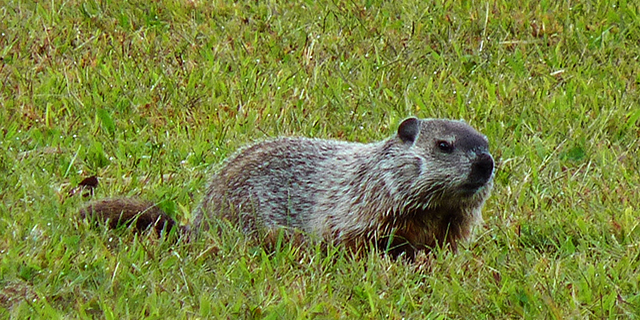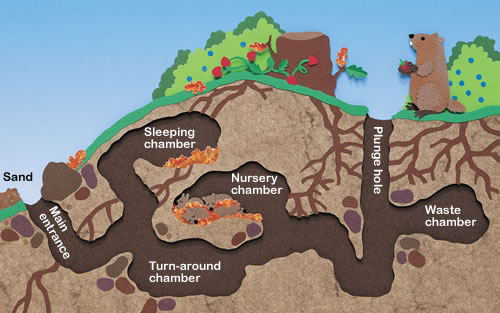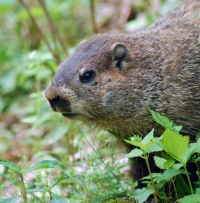One of my all-time favorite movies is Groundhog Day. Bill Murray's deadpan delivery, the kidnapped groundhog gone wild scenes, the failed attempts by Phil to achieve a perfection that doesn't exist - the movie makes me laugh out loud every viewing. This morning I was reminded of my favorite movie when a volunteer asked me if I had seen a woodchuck lately. And while I would love to see the rotund furry critter in the middle of winter, I know that right now in the dead of December, our woodchucks are probably all tucked away in cozy dens somewhere dreaming of warmer days to come.

The woodchuck (Mamota monax), aka the groundhog, is a true hibernator. Woodchucks, ground squirrels and bats are the only true hibernators in the state of Wisconsin. They go into a state of dormancy where their body drops to 40 degrees Fahrenheit to match the surrounding ambient air temperature. Because the woodchuck has a preference for perishable herbs and greens, it does not have the option of waking up to eat a cache of nuts stored in its burrow. An animal in hibernation can not be aroused or awakened even if disturbed. It remains in the catatonic-like state by slowing down its internal organs, reducing its breaths and heartbeat and putting on an excessive amount of fat around specific parts of its body (usually the important internal organs). An animal will lose 40% of its body mass during hibernation. A hibernating animal will arouse and move around for very brief periods of time every few weeks and then re-enter its dormancy. Hibernation is a dangerous period of time for a woodchuck. Many animals that enter hibernation never wake up and it is a costly process in which to invest. The Wisconsin woodchuck will hibernate from October to late-March and will emerge again in April. This is contrary to the folk legend that groundhogs emerge in February to prognosticate the arrival of spring.
 |
|
| Graphic from Highlights Kids |
This native marmot is the largest Wisconsin mammal in the squirrel family. The woodchuck is grizzled brown in appearance with bits of yellow, black and red coloring in its fur. It has stubby, rounded ears and black feet while its bushy tail is about 25% the length of the animal. The woodchuck's stout body and powerful stocky legs are adept to digging. It spends the majority of its time in an extensive underground burrow. It digs a tunnel with a mounded entrance hole and another less visible plunge hole which it uses to quickly escape danger into a subterranean system. The tidy woodchuck builds a neatly insulated nest cavity in which to rear young, a hibernation chamber and a separate toilet chamber. The woodchuck never ventures far from its burrow and will forage among well-defined paths leading to the entrance chamber. This large squirrel will emit a high-pitched whistle when frightened (earning him the nick-name "whistle-pig"), and quickly retreat back to its chamber as a line of defense.
A woodchuck grazes on herbs and grasses and has a sweet-tooth for dandelions. In the wild, other staples in his diet include clover, daisies and goldenrod. Farmers and gardeners often consider the whistle-pig a nuisance however, because of its tendency to munch on crops such as soybeans, carrots and corn. When food is scarce, the woodchuck will add bark, buds, sumac and black cherry to its diet. It can be found living in a variety of habitats from prairies and pastures to woodlands.
Male woodchucks will emerge in the spring first to fight with one another for breeding privileges with females. The female woodchuck comes out of hibernation a week or two after the male and will mate immediately upon emergence. She will rear a litter of between 2-5 per year, about a month after copulation. The young are weaned at 6 weeks of age and will disperse shortly thereafter. While the young are often preyed upon by foxes, bears, and hawks, humans are probably their biggest threat. Thousands are killed every year when they are run-over by cars or killed by hunters and farmers. The animal has adapted well to human intrusion though and its population is stabilizing. They are now considered fairly common and although their status is protected, their success has led to consideration of an open hunting season.
Fun Facts:
-
Woodchucks can live up to 6 years of age in the wild, but have an average life-span of almost 3 years.
Comic by Rick London - How much wood could a woodchuck chuck? The answer is none! Woodchucks do not eat wood, but instead prefer herbs and grasses.
- Let a hibernating woodchuck lie! Rousing an animal during hibernation will not awaken it, but will often start a chemical process which leads to an early emergence from hibernation. An early emergence means food supplies will not be readily available and the animal could starve to death.
- The woodchuck is actually a rodent, but unlike most rodents, their incisors stay white instead of turning the more common yellow discoloration.
- Is that a bird in that tree? No wait, it's a woodchuck! When food supplies are less than ideal, the woodchuck will climb trees in search of sustenance.
- The name woodchuck comes from the Cree Indian word "wuchak" referring to a variety of little brown mammals.





